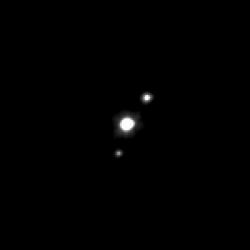Haumea (simvolı: ![]() )[9] — Günəş sisteminə daxil olan 5 cırtdan planetdən biridir. 2004-cü ildə amerikalı astronom Mayk Braun tərəfindən kəşf olunmuşdur. 2008-ci ildə Beynəlxalq Astronomiya İttifaqı Haumeaya cırtdan planet statusu vermişdir.
)[9] — Günəş sisteminə daxil olan 5 cırtdan planetdən biridir. 2004-cü ildə amerikalı astronom Mayk Braun tərəfindən kəşf olunmuşdur. 2008-ci ildə Beynəlxalq Astronomiya İttifaqı Haumeaya cırtdan planet statusu vermişdir.
| Haumea | |
|---|---|
 | |
| Kəşfi | |
| Kəşf tarixi | 25 iyul 2005[1] |
| Orbital xarakteristikaları | |
| Perisentri | 34,4961098 ± 0 a.v. |
| Aposentri | 51,42578144 ± 0 a.v. |
Böyük yarımoxu |
42,96094562 ± 0 a.v. |
| Orbitinin ekssentrisiteti | 0,1970356028 ± 0 |
Siderik dolanma dövrü |
281,59111696 ± 0,00039869 il |
| Orta anomaliyası | 221,56788975 ± 0,0010451 ° |
| Orbitin meyli | 28,2083462416±0,0000011649 dərəcə |
Qalxan düyünün uzunluğu |
121,825359899±0,000018178 dərəcə |
Perisentr arqumenti |
240,97484667 ± 0,00070881 ° |
| Nəyin peykidir | Günəş |
| Fiziki xarakteristikaları | |
| Həcmi | 1.980.000.000 km³[2][3] |
| Kütləsi | 4,006 ± 0,04 Zq[4] |
Orta sıxlığı |
2,018 q/sm³[2] |
Sinodik fırlanma dövrü |
3,91531 ± 0 saat[5] |
Şimal qütbünün birbaşa çıxması |
282,6±1,2 dərəcə |
Şimal qütbünün meyli |
−13±1,3 dərəcə, −11,8±1,2 dərəcə |
| Albedo | 0,51 ± 0,02[6], 0,33 ± 0,03[7] |
| Temperatur | 50 K[8] |
Mütləq ulduz ölçüsü |
0,15 |
- ↑ https://www.nytimes.com/2005/09/13/science/space/one-find-two-astronomers-an-ethical-brawl.html.
- ↑ 1 2 Dunham E. T., Desch S. J., Probst L. Haumea’s Shape, Composition, and Internal Structure (ing.). // Astrophys. J. / E. Vishniac IOP Publishing, 2019. Vol. 877, Iss. 1. P. 41. ISSN 0004-637X; 1538-4357 doi:10.3847/1538-4357/AB13B3 arXiv:1904.00522
- ↑ https://www.wolframalpha.com/input/?i=ellipsoid+volume+semi-axis+lengths+1050+840+537.
- ↑ Ragozzine D., Brown M. E. Orbits and masses of the satellites of the dwarf planet Haumea (2003 EL61) (ing.). // Astron. J. / J. G. III, E. Vishniac NYC: IOP Publishing, AAS, University of Chicago Press, AIP, 2009. Vol. 137, Iss. 6. P. 4766–4776. ISSN 0004-6256; 1538-3881 doi:10.1088/0004-6256/137/6/4766 arXiv:0903.4213
- ↑ Lellouch E., Kiss C., Müller T. G., Santos-Sanz P., Fornasier S., Groussin O., Lacerda P., Ortiz J. L., Thirouin A., Henry F. et al. TNOs are Cool: A survey of the trans-Neptunian region. II. The thermal lightcurve of (136108) Haumea (ing.): II. The thermal lightcurve of (136108) Haumea. // Astron. Astrophys. / T. Forveille EDP Sciences, 2010. Vol. 518. P. 147–147. ISSN 0004-6361; 0365-0138; 1432-0746; 1286-4846 doi:10.1051/0004-6361/201014648 arXiv:1006.0095
- ↑ Ortiz J. L., Santos-Sanz P., Sicardy B., Bérard D., Benedetti-Rossi G., Palomino N. F. M., Duffard R., Ries C., Hopp U., Braga-Ribas F. et al. The size, shape, density and ring of the dwarf planet Haumea from a stellar occultation (ing.). // Nature / M. Skipper NPG, Springer Science+Business Media, 2017. Vol. 550, Iss. 7675. P. 219–223. ISSN 1476-4687; 0028-0836 doi:10.1038/NATURE24051 PMID:29022593 arXiv:2006.03113
- ↑ Verbiscer A. J., Helfenstein P., Porter S. B., Benecchi S. D., Kavelaars J. J., Peng J., Lauer T. R., Spencer J. R., Protopapa S., Stern S. A. et al. The Diverse Shapes of Dwarf Planet and Large KBO Phase Curves Observed from New Horizons (ing.). // The planetary science journal 2022. Vol. 3, Iss. 4. ISSN 2632-3338 doi:10.3847/PSJ/AC63A6
- ↑ Trujillo C. A., Brown M. E., Barkume K. M., Schaller E. L., Rabinowitz D. L. The Surface of 2003 EL61in the Near‐Infrared (ing.). // Astrophys. J. / E. Vishniac IOP Publishing, 2007. Vol. 655, Iss. 2. P. 1172–1178. ISSN 0004-637X; 1538-4357 doi:10.1086/509861 arXiv:astro-ph/0601618
- ↑ JPL/NASA. "What is a Dwarf Planet?". Jet Propulsion Laboratory. 22 aprel 2015. 19 yanvar 2021 tarixində arxivləşdirilib. İstifadə tarixi: 19 yanvar 2022.